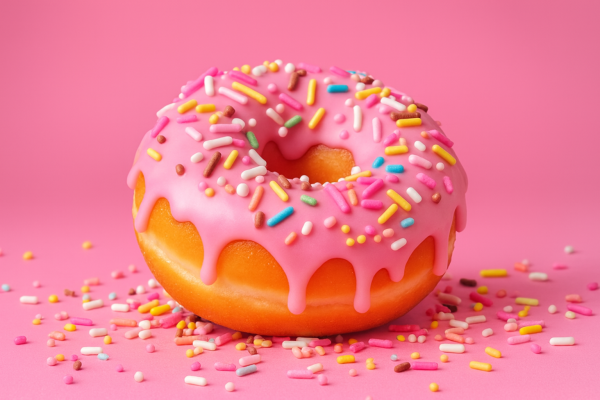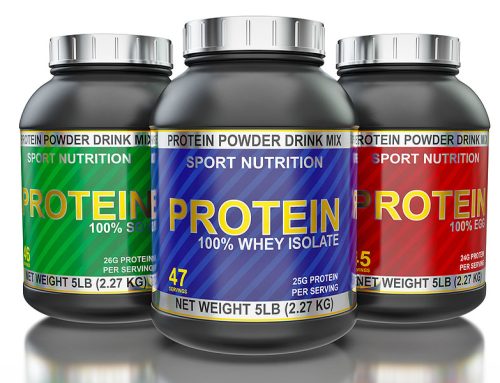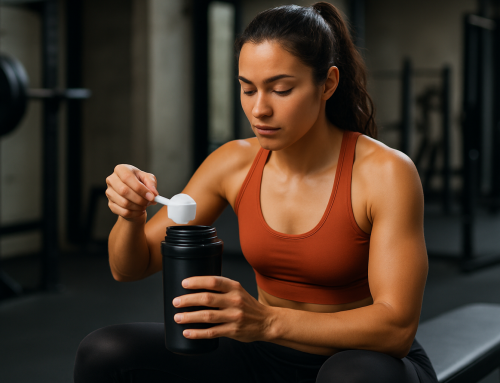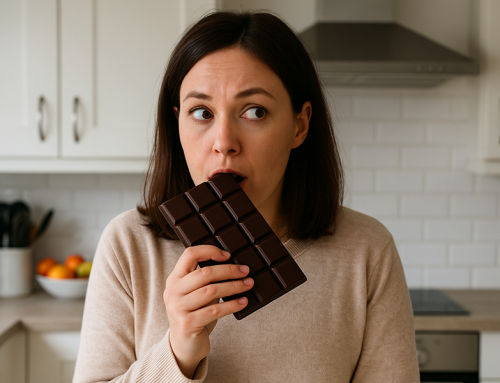High-protein junk food is everywhere today – cookies, chips, sweet rolls, pop-tart style pastries, even donuts fortified with extra protein. These products are still ultra-processed foods, but they’ve exploded in popularity as more people look for snacks that promise both indulgence and better health.

Would You Eat This If It Had 20 Grams Of Protein?
Protein bars were just the beginning. Now the food industry is doubling down on all kinds of protein snacks, and sales are soaring. But the big question is: do these “better bad choices” actually help with weight loss, or are they just junk food in disguise?
The Rise Of Ultra-Processed “Health” Food
According to a Forbes story in August of 2025, Legendary Foods did $6 million in sales in 2021. In 2022, they did $18 million in sales. It grew to $60 million in 2023 and then doubled to $120 million in 2024.
In 2025 they are projecting $180 million in sales, not surprisingly as they now have distribution in stores such as Walmart and Target. That kind of growth – more than 30X in less than 5 years – shows how quickly “high protein junk food” has exploded.
These products also have clearly grown beyond the small bodybuilding niche and into the mainstream, attracting all kinds of people who are health and weight conscious.
To their credit, the marketing claims made by these companies are fairly reserved. It’s not like they’re saying “lose 30 pounds in 30 days” on the label.
But with claims like high protein, no sugar, 2g net carbs, keto-friendly, paleo-friendly and “GLP-friendly” (whatever that means), they are certainly targeting the health and weight loss crowd and hoping consumers will see their treats as indulgent fat loss food.
Are High-Protein Snacks Still Ultra-Processed Foods?
There’s no doubt, these are processed foods. And depending on the definition you use, it’s no stretch to say these are Ultra Processed Foods (UPFs).
In fact, according to the NOVA classification criteria – which categorizes foods by their degree of processing – these products qualify 100% as ultra-processed due to ingredients like modified starches, food dyes, and industrial emulsifiers not normally used in home cooking.
Fans of these products often say that with the extra protein and no added refined sugar, “It’s got to be an improvement over the regular versions, right?” I mean if you’re craving a donut and can’t stop yourself, why not get one with high protein, lower calories, and non-nutritive sweeteners (which have almost no calories).
I’m not going to disagree with that, because indeed, these snacks have a different and much better macronutrient profile and better calorie to protein ratio than traditional UPFs.
I also don’t believe you have to cut out any foods completely to be healthy and lean if you eat them in the right kind of moderation. Yet, before you add these kinds of foods to your diet in any significant amounts, you might want to consider what research says about UPFs and where you might go wrong eating them with abandon.
The big question is, are these foods really healthy? And do they really help with weight control? A new controlled trial tested this question specifically. But first, a quick recap on important previous UPF research:
What Earlier Research Says About High-Protein Junk Food
We already knew from Kevin Hall’s landmark 2019 NIH study (which I reviewed previously), that when people were fed ultra-processed vs. un-processed diets in a metabolic ward, they ate on average 508 extra calories per day on the UPF diet. As you would obviously predict, they quickly gained weight.
New Research: Do High-Protein Junk Foods Prevent Overeating?
In a crossover trial out of the University of Kiel in Germany (Hägele et al), twenty-one adults stayed in a metabolic ward (a whole-room calorimeter) where researchers could measure food intake and energy use precisely.
Participants ate two different UPF diets, as much as they wanted:
• High-protein, lower-carb UPF diet: 30% protein / 29% carb
• Normal-protein, higher-carb UPF diet: 13% protein / 46% carbs
• Both diets were matched for fat, fiber, calories, and taste.
Here were the results of comparing high protein vs low protein ultra processed foods:
• With high-protein UPFs, people ate about 196 fewer calories per day compared to low-protein UPFs.
• And with high protein UPFs, the calorie surplus was smaller (18% surplus vs 32% surplus).
• BUT… both groups still overate and stayed in a calorie surplus.
In plain English: fortifying the junk food with extra protein helped moderate overeating a little, but sorry, not enough to stop weight gain.
Participants still ate more calories than they burned, and most important to note – they stayed in a surplus.
Comparison To Hall’s Classic UPF Study
You might have noticed that the UPF group in the Hagele study only ate 196 calories more while in the Hall study, the ultra-processed group ate 508 calories more.
That seems like a 300+ calorie discrepancy. But that’s because the study designs were different.
Hall’s trial compared two completely different diets: ultra-processed vs. unprocessed. That’s why the gap was so big – UPFs drove people to eat over 500 calories more per day than unprocessed whole foods.
Hägele’s trial compared two versions of a UPF diet. Basically a “low protein junk food diet” versus a “higher protein junk food diet.” It was still junk food. The only difference was protein content. So naturally, the gap was smaller.
Hall uncovered the basic problem: ultra-processed foods push calorie intake way up compared to whole foods.
Hägele showed that tweaking UPFs with more protein helps a little, but not nearly enough to cancel out the overeating effect.
Better Bad Choice Or Daily Staple?
Higher-protein UPFs reduce but don’t prevent overeating. The risk remains high unless you meticulously track your intake.
I’m a big advocate of Flexible Dieting but that doesn’t mean eating a ton of processed food and not even keeping track of the amount. It means fitting treats into your macro and calorie budget.
Getting 90% of your weekly calories from unprocessed food and 10% anything goes is a very sensible rule, especially because none of your favorite foods are banned. Heck, with a flexible macro-based system, you could eat REAL cookies, REAL donuts, or REAL pop tarts and you’ll still lose fat.
We could argue that these high protein UPFs readily available today are a “better bad choice” for helping with protein goals and avoiding refined added sugars. But they’re still not a “best” choice.
“Best Choice” Alternatives To Protein Junk Food
High-protein ultra-processed foods displace calories you could have consumed that have more nutritional value. That’s why it still makes sense to save them for convenience and not make them daily staples. Whole, unprocessed foods are always the best choice.
Also consider that for convenience, something as simple as protein powder in a shaker bottle is a much better choice. It’s a lot cheaper too – go compare the prices per serving and see for yourself. Most of these convenience snacks are expensive.
When you have a hankering for something indulgent, the best choice is to make protein powder fortified desserts, snacks, and treats yourself at home. They’ll be much healthier and you’ll have control over the ingredients and macros.
Lots of homemade options in our Burn The Fat Inner Circle recipe archive. I mean c’mon guys! Quest Nutrition literally started in someone’s kitchen (so hit your kitchen, and get cooking!)
The Bottom Line On High-Protein Junk Food And Weight Loss
My take: If you don’t like them, don’t eat them. If you like them, and or they help you hit your daily protein goals go ahead and enjoy them occasionally in moderation – same as with any other processed foods. Pizza once in a while? Fine. Chocolate once in a while? Fine. Donuts once in a while? Fine.
But doing it without getting fat and sick means fitting them inside a flexible diet where 90% (at least 80%) of weekly calories come from unprocessed foods AND tracking your intake. You can’t get away with eating this stuff ad libitum!
When ultra-processed foods are eaten within a calorie budget, the overeating problem is controlled by tracking. You get convenience and taste without the caloric surplus.
I think this should sound like a reasonable position to anyone who is evidence-based. As for the natural foodies who scream “Chemicals! Artificial! Poison in any amount!” – that’ll have to be a long rant for another day.
Tom Venuto,
Founder of Burn The Fat Inner Circle
Author of Flexible Meal Planning For Fat Loss
PS. What is your opinion of protein fortified “junk foods?” Are some protein bars getting more nutritious by including whole food ingredients and fiber? Do you think they taste like sawdust? Or do you enjoy them? How often? Only for occasional convenience protein or daily? What about high protein pop tarts, donuts or chips? Comment on Facebook or comment below
Scientific references:
Hägele, F.A.,et al, Short-term effects of high-protein, lower-carbohydrate ultra-processed foods on human energy balance. Nature Metabolism, 7, 704–713, 2025
Hall K et al, Ultra-processed diets cause excess calorie intake and weight gain: A one-month inpatient randomized controlled trial of ad libitum food intake, NutriXiv, 11, 2019.
More in Burn the Fat Inner Circle Members Area:
Ultra-Processed Foods and Weight Gain: What The Latest Research Reveals






Leave A Comment